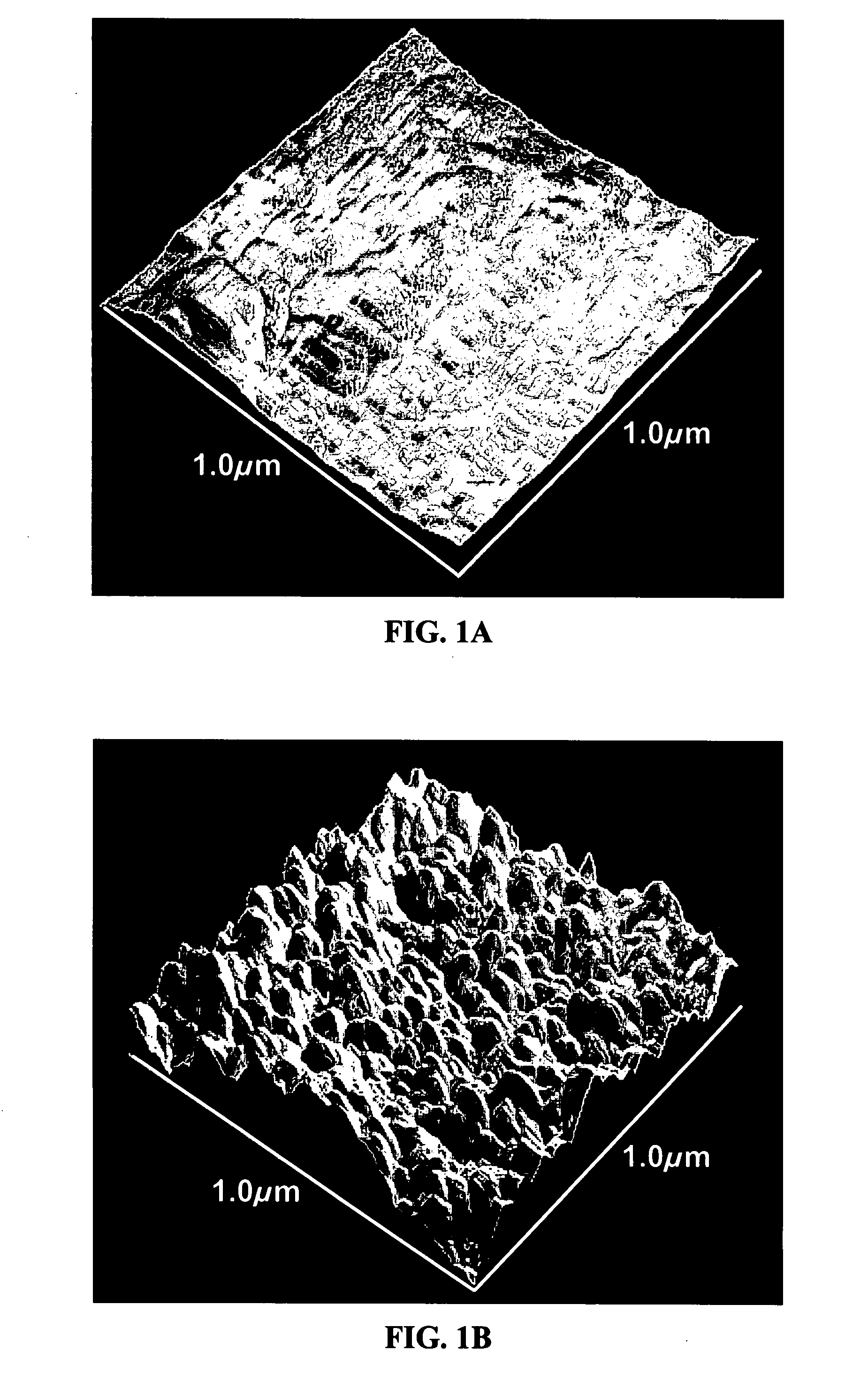Hydroxyapatite coated nanostructured titanium surfaces
a technology of hydroxyapatite and titanium, applied in the field of biomaterials, can solve the problems of long-term failure of titanium implants, insufficient bioactivity of normal oxide layer of titanium (tiosub>2/sub>), and insufficient mechanical and chemical methods to achieve high-controllable surface properties, and achieve the effect of promoting the accumulation of calcium-containing minerals and enhancing adhesion
- Summary
- Abstract
- Description
- Claims
- Application Information
AI Technical Summary
Benefits of technology
Problems solved by technology
Method used
Image
Examples
example 1
Preparation of Hydroxyapatite
Nanoparticulate HA
[0067]Hydroxyapatite is formed in accordance with the reaction:
10Ca(NO3)2+6(NH4)2HPO4+8NH4OH→Ca10(PO4)6(OH)2+6H2O+20NH4NO3
[0068]Nanoparticulate HA was synthesized suing a wet chemical process followed by hydrothermal treatment. Concentrated ammonium hydroxide was used to maintain the reaction mixture at pH 10 throughout the reaction. 0.6M ammonium phosphate and 1.0M calcium nitrate were also added slowly at 3.6 ml / min. Calcium phosphate precipitation occurred while stirring for 10 min at room temperature. After 10 min, suspension volume was reduced by 75% using centrifugation. The concentrated HA precipitated aqueous solution was added to a 125 ml TEFLON liner (Parr Instruments). The liner was sealed tightly in an autoclave (Parr Acid Digestion Bomb 4748) and processed hydrothermally at 120° C. for 20 hr. After hydrothermal treatment, the HA particles were rinsed 3 times with deionized water.
[0069]Nanoparticulate hydroxyapatite was cha...
example 2
Anodization of Titanium Substrates
[0076]Ti samples (10×10×1 mm), 99.7% pure (Alfa Aesar), 250 um thick, were cleaned ultrasonically with ethanol and water before being etched in a mixture of HF / HNO3. The pretreated samples were anodized in 1.5% hydrofluoric acid. A DC power supply with a current density of 7 A / m2 was used. A 10V anodizing voltage was applied for 10 min. Samples were rinsed with deionized water and dried with nitrogen immediately after anodization. Prior to exposure to cell cultures, the titanium samples were ultrasonically cleaned and sterilized in 70% ethanol for 15 min, rinsed in deionized water and air dried under a laminar flow hood.
[0077]Alternatively, etching time may be carried out for minutes to hours and / or the electrolyte can be hydrofluoric acid (HF) or mixtures of HF with dimethylsulfoxide (DMSO) in various ratios. Such modifications, which are known in the art, result in nanotube structures having different tube diameters and heights.
[0078]The anodized ...
example 3
HA Coated Ti Substrates
[0079]XRD on nano-HA coated nanotubular Ti indicated that the HA single phase was maintained after deposition and heating of the coated substrates up to 500° C. SEM images of the nanoHA coating at 200° C. (FIG. 5A) and 500° C. (FIG. 5B) confirmed the HA nanostructure.
[0080]However, after curing at 900° C., the nanostructure features were lost (FIG. 5C). AFM images of nanoHA coated Ti heated at 200° C. (FIG. 6A), at 500° C. (FIG. 6B) and at 900° C. (FIG. 6C) show that the HA nanostructure is altered after curing at 900° C. and loses nanostructure features. Agglomeration begins to occur at 500° C. and particle shapes have changed from nano to broadly distributed micron size particles.
[0081]Stability of the nanoHA coating on nanotubular Ti surfaces was tested by soaking in DMEM media at 37° C. for 4 hr and 24 hr. The substrates were rinsed 1× with phosphate buffer followed by 3× with deionized water and 3× with anhydrous ethanol. Coated substrates were dried unde...
PUM
| Property | Measurement | Unit |
|---|---|---|
| diameter | aaaaa | aaaaa |
| diameter | aaaaa | aaaaa |
| thickness | aaaaa | aaaaa |
Abstract
Description
Claims
Application Information
 Login to View More
Login to View More - R&D
- Intellectual Property
- Life Sciences
- Materials
- Tech Scout
- Unparalleled Data Quality
- Higher Quality Content
- 60% Fewer Hallucinations
Browse by: Latest US Patents, China's latest patents, Technical Efficacy Thesaurus, Application Domain, Technology Topic, Popular Technical Reports.
© 2025 PatSnap. All rights reserved.Legal|Privacy policy|Modern Slavery Act Transparency Statement|Sitemap|About US| Contact US: help@patsnap.com



